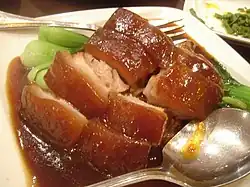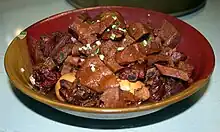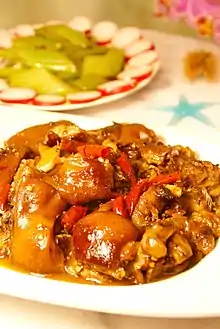Red cooking
Red cooking, also called Chinese stewing, red stewing, red braising, or flavor potting, is a slow braising Chinese cooking technique that imparts a reddish-brown coloration to the prepared food. Red cooking is popular throughout most of northern, eastern, and southeastern China.
| Part of a series on |
| Chinese cuisine |
|---|
 |

There are two types of red cooking:
- Hongshao (traditional Chinese: 紅燒; simplified Chinese: 红烧; pinyin: hóngshāo): can be done in less than 20 minutes and usually does not require much water
- Lu (traditional Chinese: 滷; simplified Chinese: 卤; pinyin: lǔ): usually requires prolonged cooking of up to several hours and the items must be submerged in the cooking liquid.
Types


Soy sauce (usually a mix of light and dark soy sauce), fermented bean paste, red fermented tofu or rock sugar is commonly used to both flavor and impart a reddish brown hue to the items being cooked. Food coloring is sometimes added for a more intense red coloration. Both lu and hongshao are forms of stewing or braising characterized by usage of soy sauce, Chinese rice wine (Shaoxing wine, huangjiu etc.) and rock sugar. Whole spices (star anise, black cardamom (caoguo), cassia, and/or fennel seeds) or five-spice powder are crucial elements in these dishes but are used in moderation so that their flavors do not overwhelm the main ingredients.
Red-cooked stews may be heavy in meat content or contain a variety of meats, vegetables, and hard-boiled eggs. Such dishes may be served hot or cold, and the sauce or stock is often reused as master stock.
See also
References
- Charmaine Solomon's Encyclopedia of Asian Food, Charmaine Solomon, 1998, Tuttle, ISBN 962-593-417-0
- Chinese Cooking for Dummies, Martin Yan, 2000, For Dummies, ISBN 0-7645-5247-3
- Martin Yan's Invitation to Chinese Cooking, Martin Yan, 2000, Bay Books, ISBN 1-57959-504-9
- Xiandai Hanyu Cidian (Modern Chinese Dictionary), Shang Wu Press, Beijing, 1996, ISBN 7-100-01777-7